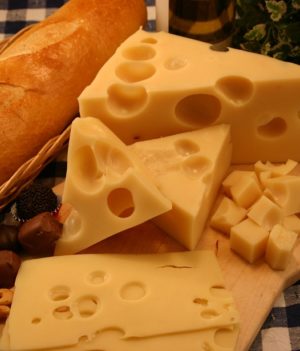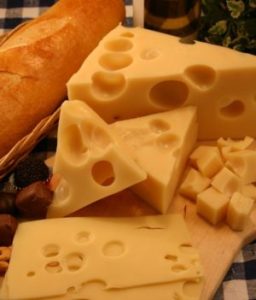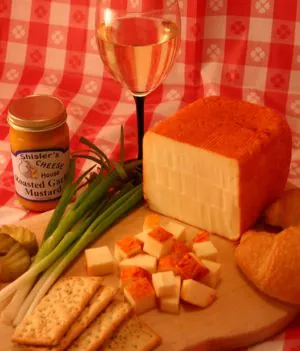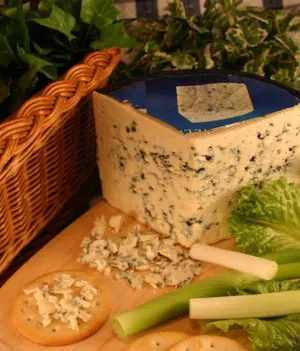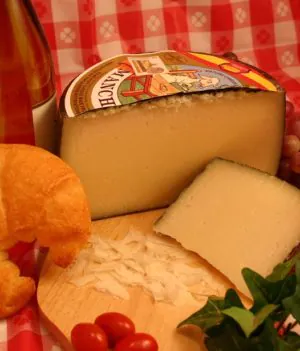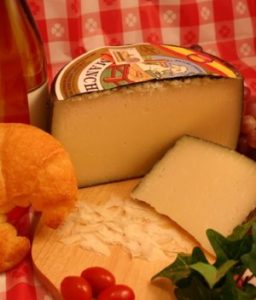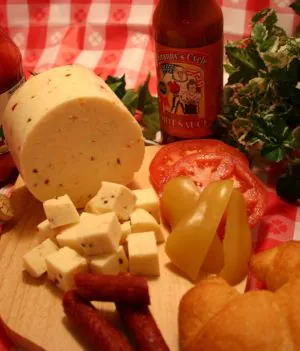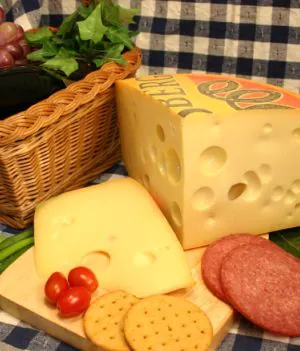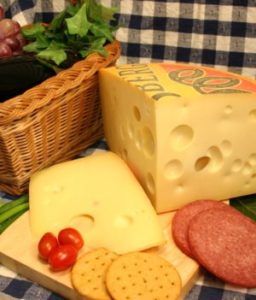Month: July 2018
Swiss Cheese: Everything You Need to Know
What is Swiss Cheese?
A holey, semi-hard cheese with a creamy color.
How does it taste?
It has a nutty, slightly piquant flavor whilst simultaneously being somewhat creamy.
How is Swiss Cheese made?
The process of making Swiss cheese involves natural bacteria consuming the lactic acid in the cheese. This releases carbon dioxide gas, which forms bubbles that become the holes in the cheese. These are often referred to as “eyes”. Our Amish swiss cheese, made in Northeastern Ohio, is especially flavorful because of the longer aging process that it undergoes, at a higher temperature than younger cheeses. This produces larger eyes, which is sometimes seen as an indicator for better flavor.
The milk used in our Swiss cheese does not have preservatives added and is always from cows that have not been given hormones or antibiotics.
We also offer Baby Swiss, which substitutes water for the milk’s whey to slow the bacterial action. This creates smaller holes and a milder flavor. Lacy Swiss is another variety of Swiss cheese, made with low-fat milk. We even offer smoked Swiss cheese.
How should I eat it?
Swiss cheese is delicious in a sandwich or served cut into cubes alongside salads and hams. It works well with most meats and is particularly good with a beef burger.
Use it as fondue or mix it into dips for a fun dinner party meal or appetizer.
For breakfast, eat a slice of it with ham in a croissant. You could even have fruit with it, as it has a nutty, caramel quality that complements apples and grapes well. It’s also very good with pickled fruits or vegetables. Consider adding them to your next cheeseboard for flavor and bite.
You could add an extra punch of flavor to your favorite mac and cheese by grating in some Swiss cheese. It is equally good with other pasta dishes, such as a creamy spaghetti or a linguine with vegetables. Use it with your breadcrumbs when making schnitzel for an extra crispy, cheesy bite.
What should I drink it with?
It goes well with Belgian ales or other creamy beers such as a pale ale. A light red wine such as Pinot Noir or Zinfandel won’t overpower the light flavor of the cheese but will bring out its sweetness. You may also find that crisp white wines such as Rieslings make a good companion for this cheese.
For a non-alcoholic option, an apple cider would be a good option as the apple flavors will offer a honey quality alongside the cheese.
How do you like to eat Swiss Cheese? Let us know in the comments!
Muenster Cheese: Everything You Need to Know
We continue our exploration of different cheeses today with a look at Muenster cheese.
What is Muenster cheese?
Muenster cheese is a mild, white cheese with a reddish-orange rind made from paprika. This can be eaten but is often cut off. It is semi-firm in texture with a mild smell that stronger as it ages. Muenster cheese is currently made in Germany, France and the United States.
The History of Muenster cheese
It was originally made by Benedictine monks that migrated to the Alsace region of France. The cheese was created to save milk and feed numerous people. The original name “munster” comes from the word monastery. Authentic French Muenster cheese is made from the milk of cows that graze in the Vosges mountains of eastern France. Today, farmers still use the traditional methods of cheese-making.
How does it taste?
Muenster cheese can be very mild and creamy, but as it ages it becomes more sharp and tangy. It is sometimes described as a cross between a mild cheddar and a mozzarella flavor.
How should I eat it?
This cheese melts well, so it’s great for putting in burgers or a grilled cheese. Pop a slice over a burger whilst it’s still on the grill for the full, melted effect. Use your favorite bread to make your ideal grilled sandwich.
Because it can be mild, this is a great cheese for adding texture and flavor without overpowering the other ingredients in a dish. You could use it in macaroni cheese or on a pizza.
It is delicious in a baked potato. Simply cut the top open and grate some cheese in. Let it melt a little before eating. You could also add a little when making scalloped potatoes. The combination of cream, mild cheese, and well-cooked potato makes for a great side dish.
Its slightly salty nature makes Muenster a good cheese to pop in a sandwich, as it adds both texture and seasoning. Try it with ham or in a turkey sandwich with salad.
If you enjoy eating fondue, you could add a little Muenster cheese for additional flavor. Alternatively, serve cubes of it on the side as an extra cheesy bite. This is also a great way to serve it as part of a cheeseboard.
If you’re serving a continental breakfast, this cheese is a great option as it won’t be an overpowering flavor first thing in the morning. It works well with ham, pastries, or even fruit such as apples and grapes.
What should I drink it with?
You’ll find Muenster cheese is often served with beer as the flavors complement each other well. A Pilsner could be a great pairing. If you prefer wine, there are a variety of red and white wines that pair well. For red wine lovers, try a light Pinot Noir or Zinfandel. If you prefer white wine, we recommend a Riesling.
How do you like to eat your Muenster cheese? Do you eat the rind? Let us know in the comments!
Buy Muenster Cheese Online @ $6.49 per lb : Click Here
Cheese Curds: Everything You Need to Know
We love to tell you more about our different products here on the blog. We’ve noticed that there are often questions about our cheese curds so we’ve chosen to answer them today.
What are cheese curds?
They are fresh, young cheddar cheese in the natural, random shape and form that the cheese takes before being processed and aged. If you live somewhere without a cheese factory, you may not have encountered them before. They have the same firmness as cheese, but with a springy or rubbery texture. Fresh curds are squeaky when bitten into because of the air trapped within. They are sometimes referred to as “squeaky cheese”!
What do cheese curds taste like?
Curds have a mild taste, somewhat like the cheddar that we are used to. They are sometimes salty and can also be flavored.
Where can I buy cheese curds?
If you’re looking for where to buy cheese curds, then you need to look no further. Here at Shisler’s Cheese House, we stock Fresh Cheddar, Roasted Garlic, and Buffalo Wing cheese curds.
Ours are made in Upstate New York and we truly believe that they are the best around.
How should I eat cheese curds?
Deep-fried cheese curds are sometimes found at carnivals and fairs in the Midwestern United States. They are covered with batter or breaded and placed in a deep fryer to create a crisp outer coating.
If you have ever been to Canada, you may have eaten poutine. This is a dish combining French fries, cheese curds, and gravy. Sometimes other toppings are added. It’s a decadent dish and particularly good if you’ve slightly over-indulged in the bar the night before!
They are delicious on a skewer combined with antipasti meats, olives, and tomatoes. You could also melt them onto a pizza or toss them into a salad. They’re a great garnish for a Bloody Mary.
If you are making burgers, incorporating curds into the mix can add both flavor and texture. For a healthier option, they are lovely stirred into a pasta salad. We think our roasted garlic curds are some of the best for this.
Buffalo wing curds can almost be an alternative to real chicken wings. Serve them with a side of celery and some blue cheese or ranch dressing for the classic flavors.
If you want to surprise your guests with something new, serve them up on a cheeseboard and see if anyone can tell you what they are.
What should I drink with cheese curds?
Classic cheddar flavors pair well with beer, red wine or even a fortified wine such as Port. Consider the rest of the dish that you are serving when selecting your drinks. Poutine pairs well with beer or a rich Pinot Noir. Spicy buffalo flavors are great with cocktails like a martini or a mojito. Roasted garlic is delicious with a light, summery rosé wine.
Do you love cheese curds? Or are you trying them for the first time? Let us know in the comments!
Why do we eat moldy cheese?

It’s a question that a lot of cheese lovers will hear: why do we eat moldy cheese?
There are some molds that are safe to eat. These are used to make cheeses such as Brie, Blue Cheese, and Camembert.
For Blue Cheese, Penicillium cultures added creating dark blue or blue-grey veins throughout the cheese. These are safe to eat because they do not produce the toxins that could be harmful to us.
The way that Blue Cheese is aged creates a level of acidity, salinity, moisture, density, temperature, and oxygen flow that cannot create dangerous molds.
In fact, our bodies can use the variety of different properties found in blue cheese to contribute to our healthy digestion.
Blue molds cause a breakdown of proteins in cheese known as proteolysis which creates a very creamy taste and texture. It also breaks down the fats, known as lipolysis, which gives blue cheese the tangy, sharp flavors that people love.
One of the reasons that people love moldy cheese is because these cheese often contain much more salt than other cheeses. Combined with the blue veins and whole milk, this creates a flavor that makes you want to eat more and more.
Blue cheese was discovered almost by accident. Cheeses in Europe were aged in high moisture caves which are also ideal environments to produce mold. Gorgonzola dates back to around 879 AD and Roquefort was invented in 1070. Today, all Roquefort eaten around the world is still made in the small French village where it was invented.
If you love rich, tannic red wines such as Cabernet Sauvignon or Pinot Noir then you are likely to enjoy moldy cheese with it as you like strong flavors. Sometimes, we develop a stronger love for blue cheeses as we age because our taste buds reduce in strength. This means that flavors that we might not have enjoyed in childhood or younger years can become some of our favorite foods. People will often experience this with other strong flavored foods such as olives.
If you are looking to try more blue cheese, enjoy it with crackers or melted into dishes, to begin with. You’ll be able to build up to eating more of it over time. It’s also delicious with Port and Scotch if you are having a cheeseboard after dinner.
So, next time you are asked why you eat moldy cheese, or whether it’s safe to eat, you’ll know how to answer!
Do you like to eat moldy cheese? Let us know how you like to eat it in the comments!
Manchego Cheese: Everything you Need to Know
What is Manchego Cheese?
Manchego is a sheep’s milk cheese from Spain. The shape of Manchego cheese is very characteristic and defined. It has an intense taste and crumbly texture which makes it perfect for eating alone. It has a rich golden color and small holes.
It is traditionally made with grass molds so it has a very distinctive zigzag pattern on the cheese. It appears as a herringbone pattern n the rind, which is inedible.
How is Manchego cheese aged?
The rich, semi-firm product is aged in natural caves for two to six months, giving it a zest and exuberant flavor. It is always aged for a minimum of two months.
There are significant changes in the flavor over time and sometimes in Spain, you will see it served in a variety of ages.
History of Manchego Cheese
Manchego cheese is made in the La Mancha region of Spain. It has a long historical and literary tradition, as it was mentioned by Cervantes in the legendary “Don Quixote of La Mancha”.
It is made from the whole milk of the Manchega sheep, which are only bred in the La Mancha region. Archaeological remains show that a cheese like Manchego may have been made as far back as the Bronze Age.
What does it taste like?
It has a caramel, nutty flavor with some acidity. The longer it is aged, the more the flavor resembles butterscotch.
How should I eat it?
Manchego is a great cheese for eating on its own or as part of a cheese board. It pairs beautifully with fruits such as figs and plums. It’s also delicious with fruity chutneys.
Membrillo, a quince paste, is often served with Manchego Cheese as the textures and flavors create a great contrast.
It’s also great with savory flavors such as olives, sundried tomatoes, and crusty bread.
It also grills well so it can be delicious in a grilled cheese or grated over baked pasta dishes instead of parmesan. We love it in quesadillas with some spicy chorizo.
If you are serving a tapas dinner, a block of manchego is a great addition to the table. Add some bread and a bottle of red wine – you’ll keep all your guests happy.
What should I drink with Manchego Cheese?
It pairs well with a robust red wine such as Rioja or Tempranillo. It is also delicious with a glass of dry sherry.
The aromatic intensity of a Manzanilla wine also makes it an excellent foil for Manchego cheese.
Have you tried Manchego? How do you like to eat it? Let us know in the comments!
Limburger Cheese: Everything You Need to Know
We’re continuing our mission to show you all the cheese that we can by telling you all about Limburger Cheese.
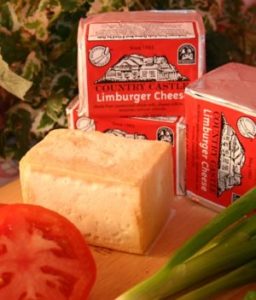
What is Limburger Cheese?
Limburger is rated as one of the stinkiest cheeses in the world! It is a spreadable cheese with an almost bitter flavor. A rind washed cheese, it has a distinct brown-colored rind with semi-soft, ivory cheese inside.
How does Limburger Cheese mature?
The bacteria Brevibacterium linens causes the odor and the maturing process which creates Limburger. When it is young it has a firm, crumbly texture with a salty flavor, like feta. At six weeks, the edges soften but the center stays firm. By two months it is almost all smooth and creamy and by three months it develops its intense smell and flavor.
History of Limburger Cheese
Limburger originated in the historical Duchy of Limburg, which is now divided between modern-day Netherlands, Belgium, and Germany. However, most Limburger today comes from Germany. Only one company in the United States still makes it, the Chalet Cheese Cooperative of Monroe, Wisconsin. We’re proud to source our Limburger Cheese from Wisconsin.
What does it taste like?
It can be quite mild but it also has a distinct grassy and mushroom taste. The aftertaste has a tang to it.
How should I eat it?
One of the most traditional ways to eat Limburger Cheese is the Limburger sandwich. The cheese is spread thickly on firm rye bread with a large, thick slice of onion. The sandwich is typically served with strong black coffee or lager beer. Chunks or slices of the cheese up to 1.5 cm thick may be cut off the block and placed in the sandwich. This still remains very popular among the descendants of German immigrants residing in the Midwest of America. In Wisconsin, you can still find the Limburger sandwich on menus, accompanied with brown mustard.
It can also be used to make an extra pungent mac and cheese. Simply stir some into the sauce and top with a rye breadcrumb for some extra crunch.
We really recommend trying the Limburger sandwich for the true experience. If you love it then you can add it wherever you might usually enjoy cheese: a grilled cheese, grated on top of dishes or over fries. It may not work so well on a cheeseboard because the aroma is likely to affect your enjoyment of the other cheeses.
What should I drink with Limburger Cheese?
Limburger Cheese is too overpowering to serve with wine. It’s usually served with lager or strong black coffee. A Belgian style beer would also pair well with it.
Have you tried Limburger Cheese? Have you braved its pungent odour? Will you be trying the sandwich? Let us know in the comments!
Pepper Jack Cheese: Everything You Need to Know
What is Pepper Jack Cheese?
Pepper Jack Cheese is a cow’s milk cheese that blends the creamy, buttery flavor of Monterey Jack cheese with the intensity of spicy peppers. Jalapeños, serrano peppers, and habañero peppers are all used to create heat. As the cheese ages, the peppery flavor intensifies. Some older pepper jacks can taste quite zesty, but generally, the cheese is only aged for a few months. It will take on a creamy color and semi-firm textures.
How is Pepper Jack Cheese made?
Monterey Jack Cheese was made by the Mexican Franciscan friars of Monterey, California, in the 19th century. Then David Jack, a California businessman, decided that the market for the cheese could be developed. He produced the mild, white cheese that we now call Monterey Jack. Later, producers began to add small pieces of spicy peppers to the curds of their Jack cheese, creating Pepper Jack Cheese.
How should I eat Pepper Jack Cheese?
Pepper Jack Cheese melts very well. This makes it great for quesadillas, hot sandwiches, and nachos. Try adding it to Mexican food as these flavors pair well together.
The moist texture also makes it suitable for grating over dishes. It goes especially well with barbecued meats such as beef, and it can be used on burgers, steaks, and various broiled dishes. You could also serve cubes or slices as part of a cheese platter. Try it with melons, grapes, pickled vegetables, and olives for contrast and great texture. Slice it into sandwiches with bologna for a picnic.
Try it in mac and cheese with fresh slices of jalapeño to create a spicy side dish or comforting meal. Stuff it into a chicken breast and wrap it with bacon for a flavor explosion. You can even put a cube into the middle of a homemade burger so that you get oozing melted cheese when you bite into it.
What should I drink Pepper Jack Cheese with?
Pepper Jack Cheese goes best with slightly sweet white wines like Chardonnay, Riesling, or dessert wines. These complement the spicy and creamy nature of the cheeses. It’s also great with a light beer. You’re looking for a beer that isn’t too hoppy or powerful in flavor, as this can bring out the bitterness of the spice. Instead, go for a light lager.
Spicy cheeses
If you already love Pepper Jack Cheese and you’re looking to get even more spicy cheese into your life then we stock a huge range in the cheese shop and online. Check out our Carolina Reaper Cheese, Scorpion Cheddar, Ghost Pepper Cheese, Smoked Habanero Cheddar, Super Hot Pepper Cheese, Hot Pepper Cheese, Smoked Hot Pepper Cheese, Smoked Horseradish Cheese, Yogurt Cheese with Jalapenos, Hot Pepper Cheese Curds, and Buffalo Wing Cheese Curds.
Some of these are super hot whilst others combine chili spice with creamy cheese flavors. The smoked cheeses are great for BBQ dishes. Try them all to find your favorites!
How do you like to eat Pepper Jack Cheese? Let us know in the comments!
Buy Pepper Jack Cheese @ $ 5.99 per Lb : Click Here
Jarlsberg Cheese: Everything You Need to Know
What is Jarlsberg Cheese?
Jarlsberg cheese is from Norway and is known for its distinctive sweet and nutty taste. It has large, round holes and a very buttery texture. It is almost sweet whilst having a clean flavor.
It has become popular around the world, with huge sales in both the United States and the United Kingdom.
History of Jarlsberg Cheese
Cheese with holes has been made in Laurvig and Jarlsberg, in the south of Norway, since the 1830s. In 1956, Professor Ole M. Ystgaard from the Agricultural University of Norway began doing research on these cheese recipes, recognizing the value of this type of cheese. During his research he developed a semi-hard, medium-fat cheese with large holes, successfully combining the cheese-making traditions with modern technologies. The new cheese was named Jarlsberg Cheese after the county where the earlier version had been made.
The holes are the result of cheese cultures added according to a secret recipe that is closely guarded. The cultures will create carbon dioxide, making bubbles in the cheese that eventually leave holes.
How to eat it
This versatile cheese is great on a cheeseboard but can also be eaten in a variety of hot and cold dishes.
It’s truly awesome melted onto a burger, perfect for barbecue season. It makes an excellent fondue, ready for dipping in bread, apple slices, and celery sticks. Add it to Mac and Cheese for extra nutty, cheesy flavor. Try it in paninis with ham or mushrooms (or both!). It’s also a great cheese for grating onto any baked savory dish to add a cheesy topping.
For true simplicity, slice it thinly and make a sandwich with your favorite bread. This is one of the best ways to enjoy the flavor of the cheese without distractions.
What to drink with Jarlsberg®Cheese
To complement Jarlsberg Cheese’s sweet, nutty flavor and open texture, choose light, fresh white wines rather than reds. Dry or semi-dry whites made from Chardonnay or Riesling grapes are your best bets. Think Chablis, White Burgundy, or a light, spicy Gewürztraminer.
Jarlsberg Cheese also works well with most beers. For those with a taste for stronger drink, it combines perfectly with Aquavit, a traditional Scandinavian liquor distilled with aromatic botanicals like caraway, cumin, cardamom, orange peel, aniseed, and fennel. This creates an experience you won’t soon forget.
Imported Cheeses
Jarlsberg Cheese is one of our newer imports and we are proud to stock it. We have been adding to our selection and will continue to add more in the future. Some of our other imported cheeses include Canadian Cheddar, Chevre, Danish Bleu Cheese, Gouda, Gruyere, Manchego, Mozzarella, Parmesan, Provolone, Raclette, and Pecorino Romano.
Have you tried Jarlsberg Cheese? Let us know in the comments.
Get ready for the 4th July!
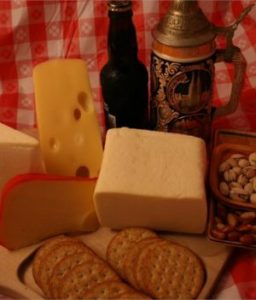
4th July is here again! We’ve put together a few tips for you to help prepare for tomorrow’s festivities.
Food
Food is, of course, one of the most important parts of any 4th July celebration!
Take a look at our barbecue checklist if you’re going to be grilling with your family. If you’re holding more of a formal dinner, read all about how to create a beautiful table setting. We know you might be serving beer, so if you’re looking for some cheese to enjoy we recommend our beer collection. It contains Brick Cheese, Gouda, Gruyere and Ohio Premium Swiss Cheese, so you’ll have a great selection to share. Add a few pickles and some ham and you’ve got a board that will keep even the hungriest guests happy.
Make it easy with a great selection of salads, grilled meats, and cheeses. Stock up on snacks to keep energy levels high and you’ll be partying into the night.
Drinks
You’ll need something to wash down all the fabulous. Check out our list of perfect summer drinks to get inspiration. It’s the perfect time to make a pitcher of something refreshing and allow everyone to help themselves. Remember that everyone needs a chance to celebrate so you don’t want to be stuck in the kitchen making food and mixing drinks!
For true simplicity, fill a cooler with beer and soft drinks and you won’t even have to worry about preparing anything.
Festivities
It’s time to set off some fireworks! Stock up and put on a real display for your family and friends. Make sure to stay safe and take all necessary precautions. You’re sure to be able to find local parties if you can’t host at home.
We love to play some games when we get together as a family. Whether it’s running around with super soakers, playing bingo or taking part in a scavenger hunt, creating a simple activity can elevate your party to the next level.
We want to wish all of our customers a happy and healthy Independence Day. We hope it means time spent with family or friends, but if it doesn’t we hope that you get to take a moment for your own personal celebration.
Let us know how you’ll be celebrating this 4th July in the comments.

